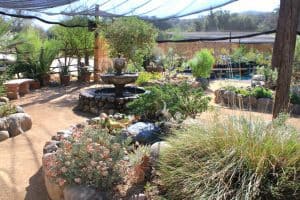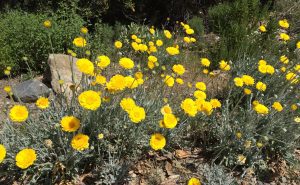If May is the month considered “pre-summer” (and it is), then September is our month of “pre-fall.” Time to catch up on late summer tasks and get ready for early fall.
History/review

The daylight hours are notably shorter and the plants are readying themselves for the rainy season still two months away. Cooler nights, shorter days, and cooler soil temps means less stress on the plants, especially in the leaves where water is lost through transpiration. During the summer months, in this series we talked a lot about watering and the potential problems concerning plant disease. September marks the month in which we start down an easier path.
Watering
We’re not out of the woods yet. September and October can produce some very high temperatures, drying Santa Ana winds, very low humidity. These fall heat waves usually only last a few days when they come, and the factor that makes them less a threat than the long hot summer, is the fact that the fall nights are cooler. To prepare for hot dry weather to come, you need to continue your summer watering patterns… “deep soak” with an irrigation event every 3-4 weeks and refreshing sprinkles about twice a week.
See June, July, and August posts and for a thorough treatment on watering native plants in summer and see our Watering Guide for all the details.
Irrigation event = deep soak, 1.5”+ precipitation by watering. Usually you have to run the sprinklers three days in a row, very early morning for 20-40 minutes each day for a cumulative run time of 1.5 to 2+ hours, and a cumulative amount totaling 1.5”+ of water in your garden. It’s like three days of rain showers. You do this about every three or four weeks May through October, during cool spells in anticipation of heat events.
Refreshing sprinkle = 5 minutes or less of sprinkler or you holding the hose with a spray nozzle, to cool the plants and the soil, wash off the leaves and freshen things up. This can be done a couple times a week or so, and always in the late afternoon or early evening. You barely get the surface of the soil wet. The plants love it.
To achieve the most success, you have to do both, “irrigation event” and “refreshing sprinkle.”
Related to Watering
If new growth on branch tips wilts when the noon day sun hits it, or during a period of Santa Ana winds, or consistently during the hot part of the day, check the same branches in the evening and morning hours. Chances are they will be back to normal. There is a term in agriculture for this. The plant is well watered and ample moisture is available in the soil, but the plant is unable to move water through its vascular system fast enough to cool its leaves. The term is one of my personal favorites, “midday depression.” Keep an eye out for it. Do not be tricked into watering if the soil does need it. The “problem” is resolved every evening. You can also prune off the new growth to allow the plant to stop stressing, but only if the branch tips have become permanently damaged.
Pruning
No major pruning in September. You can remove unsightly dry flower heads. Many people leave the brown seed heads of buckwheat on the plant a few more weeks. They are an attractive reminder of summer, they are setting seed, and they are shading the plant making the remaining hot weather a little easier to bear.

Weeding
Get those weeds out of there. Many have gone to seed. Don’t let this get ahead of you.
Mulching/Top dress
Be patient. There seems to be too big a craze over mulch mulch mulch. If your garden looks good with a few patches of bare dirt here and there, you’re fine. We’ll talk about refreshing or adding mulch in October, when the weather has changed to fall and rains are right around the corner.
Feeding
We recommend organic fertilizers, if applied as granular or dry product, scratched into the top 2” of soil with a three-prong cultivator. Towards the end of the month, just before what might be your last irrigation event of the summer, you can make your first application of plant food. Choose one with a low N-P-K (the three numbers on the bag) like 5-3-1. Most balanced plant foods also contain micronutrients like iron. Native gardens will do fine with half strength applications. This can wait until October. No rush, but if you do it in late September, water thoroughly right away.
Troubleshooting – Varmints, Pests and Diseases
Many plant pests are finishing up their boom life cycle, but with a few weeks of warm weather ahead, you can still find aphid, mealybug and scale, often associated with Argentine ants that feed off the sweet excretion made by the plant feeders. Control by 1) killing ants (growth regulators like Combat gel work, but you have to be diligent over a long season), and 2) killing plant pests with insecticidal soaps and oils. Always follow label instructions.
Annual Wildflowers
All gone. Most of your dry annuals should be mashed up and all the seed is resting on your ground, waiting for winter.
Adding New Plants
A few here and there starting September 15 will be fine. The big time for planting is so close… October and November. Stay tuned.
Engage
You made it. Your garden made it. Long hot days of summer are fading into the past. Breathe the first air of fall, watch a few migratory birds, bats, and insects readying to migrate or pupate, and you might also catch the first glimpse of a few new arrivals. Bring dried seed stalks into the house for a dry vase so as to keep the feeling alive. Head for hills for that hike you have been postponing because of the heat. And when you make those refreshing sprinklers happen, turn the hose straight up and stand in the shower mist a couple minutes. You will see why your plants so love this attention you give them at the end of a hot day.
From the Garden,
Mike Evans
Questions? Help is just one call or one email away. Call (949) 728-0695 or email (with pictures if you like) our brand new help email: gardenhelp@californianativeplants.com
Featured Photo Credit: Sarah Bryant, Tree of Life Nursery © 2016